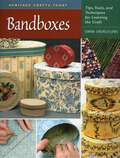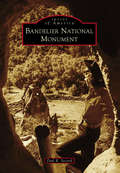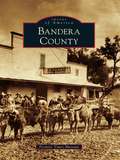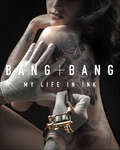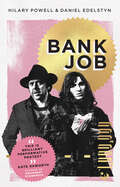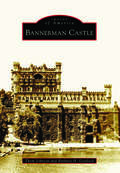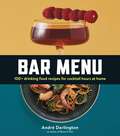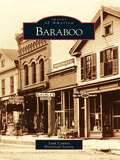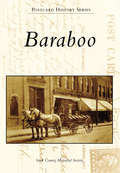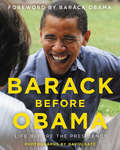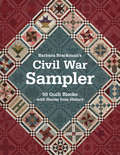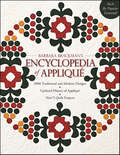- Table View
- List View
Bandana-rama Wrap, Glue, Sew: Kids Make 21 Fast & Fun Craft Projects
by Judith CressyTurn your old bandanas into stylish new creations with these 21 fast, fun and easy-to-complete crafting projects for kids ages 8 and up. Full of inspiration for crafty kids, Bandana-rama shows how the classic bandana is also the ideal crafting material. Here you will find twenty-one easy inventive crafting projects that are easy for kids of all experience levels to complete. From headbands, belts, and hoodies, to pillows, guitar straps, and hoodie linings, all the projects can be achieved by hand sewing, machine sewing, or in some cases, by simply using scissors and glue. Since bandanas are prehemmed, they cut down on time spent sewing borders and following stitching lines. As a result, there's more time for kids to explore their creativity and come up with a style that's all their own.
Bandboxes (Heritage Crafts)
by Edwina Cholmeley-JonesFirst made in Elizabethan England, bandboxes remain popular in decorating. Patterns and techniques to make your own.
Bandelier National Monument (Images of America)
by Paul R. SecordBandelier National Monument is located about 60 miles west of Santa Fe, New Mexico, on the edge of the Valles Caldera, the center of a massive extinct volcano that forms the Jemez Mountains. The 50-plus-square-mile preserve was designated a national monument in 1916 and is named for anthropologist Adolph Bandelier, the first Euro-American to describe the area and encourage its preservation. Within its boundaries are some of the most important archaeological resources and the most striking scenery in the American Southwest. With deep canyons cutting through volcanic ash, the dramatic geology of the area alone would warrant national attention. However, this is also a place that shows evidence of nearly continuous human occupation for more than 10,000 years and still retains direct links between prehistoric and living Native Americans.
Bandera County (Images of America)
by Frontier Times MuseumLocated in the picturesque Texas Hill Country, Bandera County was named for nearby Bandera Pass, a naturally occurring passageway through the neighboring hills. Near the pass, the Medina River weaves its way through the county. In 1853, a group of settlers arrived and set up camp to make shingles from the huge cypress trees that grew along the river. Soon immigrant workers from Poland were recruited to work at a newly built sawmill. The beauty and abundance of resources also attracted an early group of Mormons, who established a nearby colony. The town of Bandera was designated the county seat at the formation of Bandera County in 1856. Bandera became a staging area for cattle drives up the Western Trail, and today the county still maintains its frontier character. The Western way of life prevails as visitors from around the world come to sample cowboy living on local dude ranches and enjoy honky-tonk music and dancehalls.
Bang Bang: My Life in Ink
by Bang BangThe celebrity tattoo artist takes fans on a tour through his life and art, combining captivating vignettes and stories with more than one hundred color photos.Justin Bieber, Katy Perry, Rita Ora, Cara Delevingne, Rihanna, and many more of the hottest celebrities in the world have been seen on the red carpet, on concert stages, and in magazine spreads wearing stunning ink created by Keith “Bang Bang” McCurdy, the most in-demand tattoo artist in the entertainment world. Bang Bang’s work has taken him across the country and around the globe, to any and every locale a celebrity client may request. From Rihanna’s controversial gun tattoos, to inking Justin Bieber at 40,000 feet—a record—each of Bang Bang’s tattoos comes with its own epic story. Now, this creative genius invites readers along on his adventures, sharing amazing tales from his life and career.Named for the duel guns tattooed on his neck, Bang Bang began his career in his mom’s tiny Delaware kitchen. Self-taught, he practiced with a kit from an art store before eventually moving to New York. Over the past decade, Bang Bang’s talent and vision propelled his rise into the spotlight, and today, his fresh, accessible aesthetic draws men and women, tattoo vets and novices alike eager to experience his ultra-fluid and realistic designs created with the finest needles and inks. Bang Bang’s visual style transcends the clichés of the tattoo world; he creates a truly different form of art.Filled with engaging personal stories and striking photographs that bring his bold, vibrant designs into detail, Bang Bang is a must-have for Bang Bang fans and tattoo lovers everywhere.
Banir A Desordem: Simplifique A Sua Vida Em Apenas Um Fim-De-Semana!
by Sarah Goldberg Sónia CamõesA desordem da sua casa ou apartamento está a deixá-lo louco? Precisa de se livrar de toda a tralha e simplificar sua vida IMEDIATAMENTE? Tem vergonha de receber os seus amigos (ou a sua mãe!) por causa do excesso de desarrumação em sua casa? Então este livro é para si! Junte-se às milhares de pessoas que descarregaram este best-seller para as ajudar a tornar as suas vidas mais simples em apenas um fim-de-semana! Veja, outrora eu tive uma casa desarrumada. É verdade! A minha casa era um desastre, com todo o material dos miúdos, do meu marido, e tralha aleatória por toda a parte. Deixava-me louca! Para ser honesta, até tinha vergonha quando cá tinha os vizinhos porque parecia que tínhamos tralha por todo o lado. Mas agora não! Eu decidi-me a tirar UM FIM-DE-SEMANA da minha vida e banir para sempre a desordem, e funcionou! Agora quero ajudá-lo a fazer o mesmo, porque é ÓPTIMO ter eliminado a desordem e ter limpado a minha casa de vez. Peguei na minha tralha toda e decidi-me a vende-la no eBay e agora até tenho dinheiro extra! Este livro conduz o leitor durante um fim-de-semana, da noite de sexta-feira à noite de domingo, e dá-lhe uma guia passo a passo para por a sua casa em ordem novamente. Pode parecer uma tarefa difícil, mas experimente--não tem nada a perder e tem todas as possibilidades de tornar a sua casa ou apartamento muito mais habitável! Além do mais, também tenho recomendações para soluções de armazenamento no final do livro -- São soluções topo de gama, prateleiras resistentes de armazenamento, prateleiras, suportes, etc, que vão ajuda-lo no começar o processo para uma vida livre de desordem! Não se envergonhe com a sua casa desarrumada. Comece hoje, compre este livro, escolha um fim-de-semana e elimine a desordem para sempre!
Bank Job
by Hilary Powell Daniel EdelstynArt hacks life when two filmmakers launch a project to cancel more than £1m of high-interest debt from their local community. Bank Job is a white-knuckle ride into the dark heart of our financial system, in which filmmaker and artist duo Hilary Powell and Dan Edelstyn risk their sanity to buy up and abolish debt by printing their own money in a disused bank in Walthamstow, London. Tired of struggling in an economic system that leaves creative people on the fringes, the duo weave a different story, both risky and empowering, of self-education and mutual action. Behind the opaque language and defunct diagrams, they find a system flawed by design but ripe for hacking. This is the inspiring story of how they listen and act upon the widespread desire to change the system to meet the needs of many and not just the few. And for those among us brave enough, they show how we can do this too in our own communities one bank job at a time.
Banksy Locations & Tours Volume 2: A Collection of Graffiti Locations and Photographs from around the UK
by Martin BullFollowing the runaway success of the original edition, this unique book collects the rest of Banksy's graffiti from the last five years. With more than 100 different locations highlighted and color photographs of Banksy's street art, this is a thoroughly up-to-date catalog of his most recent work. Also included with the photographs are trivia regarding each location, a full walking tour of the remaining work in Banksy's native Bristol, and snippets of graffiti by several other artists.
Banksy Locations & Tours: A Collection of Graffiti Locations and Photographs in London, England (PM Press)
by Martin BullWhen it comes to art, London is best known for its galleries, not its graffiti. However, not if photographer Martin Bull has anything to say about it. While newspapers and magazines the world over send their critics to review the latest Damien Hirst show at the Tate Modern, Bull, in turn, is out taking photos of the latest street installations by guerilla art icon Banksy. In three guided tours, Martin Bull documents sixty-five London sites where one can see some of the most important works by the legendary political artist. Boasting over 100 color photos, Banksy: Locations and Tours also includes graffiti by many of Banksy's peers, including Eine, Faile, El Chivo, Arofish, Cept, Space Invader, Blek Le Rat, D*face, and Shepherd Fairey. This edition has updated locations and 25 additional photos.
Banksy: Completed
by Carol DiehlThere's more to Banksy than the painting on the wall: the first in-depth investigation into the mysteries of the world's most famous living artist.Banksy is the world's most famous living artist, yet no one knows who he is. For more than twenty years, his wryly political and darkly humorous spray paintings have appeared mysteriously on urban walls around the globe, generating headlines and controversy. Art critics disdain him, but the public (and the art market) love him. With this generously illustrated book, artist and critic Carol Diehl is the first author to probe the depths of the Banksy mystery. Through her exploration of his paintings, installations, writings, and Academy Award-nominated film, Exit through the Gift Shop, Diehl proves unequivocally that there's more to Banksy than the painting on the wall.Seeing Banksy as the ultimate provocateur, Diehl investigates the dramas that unfold after his works are discovered, with all of their social, economic, and political implications. She reveals how this trickster rattles the system, whether during his month-long 2013 self-styled New York "residency" or his notorious Dismaland of 2015, a full-scale dystopian "family theme park unsuitable for children" dedicated to the failure of capitalism. Banksy's work, Diehl shows, is a synthesis of conceptual art, social commentary, and political protest, played out not in museums but where it can have the most effect--on the street, in the real world. The questions Banksy raises about the uses of public and private property, the role of the global corporatocracy, the never-ending wars, and the gap between artworks as luxury goods and as vehicles of social expression, have never been more relevant.
Banksy: The Man Behind the Wall
by Will Ellsworth-JonesWhile hiding from the limelight, Banksy has made himself into one of the world's best-known living artists. His pieces have fetched millions of dollars at prestigious auction houses. He was nominated for an Academy Award for his film Exit Through the Gift Shop. Once viewed as vandalism, his work is now venerated; fans have gone so far as to dismantle the walls that he has painted on for collection and sale.But as famous as Banksy is, he is also utterly unknown—he conceals his real name, hides his face, distorts his voice, and reveals his identity to only a select few. Who is this man that has captivated millions? How did a graffiti artist from Bristol, England, find himself at the center of an artistic movement? How has someone who goes to such great lengths to keep himself hidden achieved such great notoriety? And is his anonymity a necessity to continue his vandalism—or a marketing tool to make him ever more famous?Now, in the first ever full-scale investigation of the artist, reporter Will Ellsworth-Jones pieces together the story of Banksy, building up a picture of the man and the world in which he operates. He talks to his friends and enemies, those who knew him in his early, unnoticed days, and those who have watched him try to come to terms with his newfound fame and success. And he explores the contradictions of a champion of renegade art going to greater and greater lengths to control his image and his work.Banksy offers a revealing glimpse at an enigmatic figure and a riveting account of how a self-professed vandal became an international icon—and turned the art world upside down in the process.
Bannerman Castle
by Thom Johnson Barbara H. GottlockFor generations, boaters and train passengers have been mystified and intrigued by the sight of a castlelike structure looming in the Hudson River, near Fishkill. Bannerman Castle unveils the history of this site: an island arsenal, built to resemble a Scottish castle. The story begins in 1900, when Francis Bannerman VI purchased the island--officially Pollepel but later called Bannerman's Island--for storing used military goods purchased from the government. A native of Scotland, Bannerman designed his arsenal to resemble a Scottish castle.
Bannir Le Fouillis: Simplifiez Votre Vie En Seulement Un Week-end !
by Sarah Goldberg Ayda ZarroukCe livre prend le lecteur à travers un week-end d'organisation et de nettoyage avec le produit final étant une maison ou un appartement organisé. Ce livre a été extrêmement bien reçu sur Amazon et dans Le top 100 des téléchargements gratuits pendant sa promotion gratuite. Il a atteint le #1 statut de Best-Seller de sa catégorie et il est encore un best-seller sur Amazon. Pour tirer parti de la promotion croisée, le livre est également disponible sur Audible.com.
Bansuri - Textbook of Arts class 5 - NCERT - 25
by National Council of Educational Research and TrainingBansuri: Textbook of Arts for Grade 5, published by the National Council of Educational Research and Training (NCERT), is an innovative and comprehensive resource that introduces students to the four core disciplines of art education—Visual Arts, Theatre, Music, and Dance. Designed in alignment with the National Education Policy (NEP) 2020 and the National Curriculum Framework for School Education (NCF-SE) 2023, the book aims to nurture creativity, cultural understanding, and holistic development among learners at the preparatory stage. Through an engaging blend of stories, interactive activities, and hands-on projects, it encourages students to explore self-expression, observation, imagination, and collaboration. Each section integrates cross-cutting themes such as inclusion, gender sensitivity, and cultural rootedness, ensuring that children learn not just techniques but also values and emotional intelligence. The book emphasizes experiential learning through drawing, performing, storytelling, and reflective exercises, supported by formative and summative assessments focused on creativity rather than competition. By combining artistic skill-building with ethical, emotional, and cognitive growth, Bansuri provides a joyful, inclusive, and experiential learning journey—helping children appreciate India’s artistic heritage while developing confidence, empathy, and a lifelong love for the arts.
Bansuri class 4 - NCERT - 25: बाँसुरी ४थीं कक्षा - एनसीईआरटी - २५
by Rashtriy Shaikshik Anusandhan Aur Prashikshan Parishadकक्षा 4 की हिंदी पाठ्यपुस्तक बाँसुरी राष्ट्रीय शिक्षा नीति 2020 और राष्ट्रीय पाठ्यचर्या रूपरेखा 2023 के अनुसार तैयार की गई है। इस पुस्तक में विद्यार्थियों की भाषा दक्षता, कल्पनाशक्ति, संवेदनशीलता और नैतिक मूल्यों के विकास पर विशेष ध्यान दिया गया है। इसमें कविता, कहानी, संस्मरण, संवाद और लोककथाओं के माध्यम से भाषा सीखने की प्रक्रिया को रोचक और आनंदमय बनाया गया है। बालसुलभ कथाओं और प्रसंगों द्वारा विद्यार्थियों में पर्यावरण चेतना, सहयोग, अनुशासन, परिश्रम और मानवीय मूल्यों की भावना जाग्रत की गई है। साथ ही, इसमें विभिन्न अभ्यास, प्रश्नोत्तरी, समूहगत गतिविधियाँ और सृजनात्मक कार्य दिए गए हैं, जिनसे बच्चों की पठन, लेखन और मौखिक अभिव्यक्ति की क्षमता बढ़ती है। बहुभाषिक और बहुसांस्कृतिक दृष्टिकोण अपनाकर यह पुस्तक बच्चों को भारतीय समाज, संस्कृति और परंपराओं से जोड़ती है। इस प्रकार बाँसुरी विद्यार्थियों के सर्वांगीण विकास और आनंदपूर्ण अधिगम का माध्यम बनती है।
Bansuri-1 (Konkani language) class 3 - NCERT-25: बांसुरी-१ ३रीं यत्ता - एनसीईआरटी - २५
by Rashtriy Shaikshik Anusandhan Aur Prashikshan Parishad"बांसुरी-१" हे राष्ट्रीय शैक्षणिक संशोधन व प्रशिक्षण परिषदेने (NCERT) प्रकाशित केलेले, इयत्ता तिसरीसाठी संस्कृत भाषेतील कलेचे पाठ्यपुस्तक आहे. राष्ट्रीय शिक्षण धोरण २०२० आणि राष्ट्रीय अभ्यासक्रम आराखडा २०२३ च्या आधारावर तयार केलेले हे पुस्तक कलेच्या चार प्रमुख क्षेत्रांना—दृश्यकला, संगीत, नृत्य आणि रंगमंच—विविध उपक्रम आणि सोप्या कृतींच्या माध्यमातून सादर करते. मुलांना खेळातून चित्र काढणे, गाणी म्हणणे, नृत्य करणे आणि अभिनय करणे यांसारख्या गोष्टींशी जोडून त्यांच्या सर्जनशीलतेला आणि कल्पनाशक्तीला प्रोत्साहन देणे, हा याचा मुख्य उद्देश आहे. हे पुस्तक मुलांना भारताच्या समृद्ध सांस्कृतिक परंपरांची ओळख करून देते आणि कलेच्या माध्यमातून त्यांच्या सर्वांगीण विकासावर भर देते.
Bansuri-1 (Marathi language) class 3 - NCERT-25: बांसुरी-१ ३रीं इयत्ता - एनसीईआरटी - २५
by Rashtriy Shaikshik Anusandhan Aur Prashikshan Parishad"बांसुरी-१" हे राष्ट्रीय शैक्षणिक संशोधन व प्रशिक्षण परिषदेने (NCERT) प्रकाशित केलेले, इयत्ता तिसरीसाठी संस्कृत भाषेतील कलेचे पाठ्यपुस्तक आहे. राष्ट्रीय शिक्षण धोरण २०२० आणि राष्ट्रीय अभ्यासक्रम आराखडा २०२३ च्या आधारावर तयार केलेले हे पुस्तक कलेच्या चार प्रमुख क्षेत्रांना—दृश्यकला, संगीत, नृत्य आणि रंगमंच—विविध उपक्रम आणि सोप्या कृतींच्या माध्यमातून सादर करते. मुलांना खेळातून चित्र काढणे, गाणी म्हणणे, नृत्य करणे आणि अभिनय करणे यांसारख्या गोष्टींशी जोडून त्यांच्या सर्जनशीलतेला आणि कल्पनाशक्तीला प्रोत्साहन देणे, हा याचा मुख्य उद्देश आहे. हे पुस्तक मुलांना भारताच्या समृद्ध सांस्कृतिक परंपरांची ओळख करून देते आणि कलेच्या माध्यमातून त्यांच्या सर्वांगीण विकासावर भर देते.
Bansuri-1 (Sanskrit language) class 3 - NCERT - 25: बांसुरी-१ ३रीं कक्षा - एनसीईआरटी - २५
by Rashtriy Shaikshik Anusandhan Aur Prashikshan Parishad"बांसुरी-1" राष्ट्रीय शैक्षिक अनुसंधान और प्रशिक्षण परिषद् (NCERT) द्वारा प्रकाशित कक्षा 3 के लिए संस्कृत भाषा में कला की एक पाठ्यपुस्तक है। राष्ट्रीय शिक्षा नीति 2020 और राष्ट्रीय पाठ्यचर्या की रूपरेखा 2023 के आधार पर तैयार की गई यह पुस्तक कला के चार प्रमुख क्षेत्रों—दृश्यकला, संगीत, नृत्य और रंगमंच—को विभिन्न गतिविधियों और सरल क्रियाकलापों के माध्यम से प्रस्तुत करती है। इसका उद्देश्य बच्चों को खेल-खेल में चित्र बनाने, गीत गाने, नृत्य करने और अभिनय करने जैसे कार्यों से जोड़कर उनकी रचनात्मकता और कल्पनाशीलता को प्रोत्साहित करना है। यह पुस्तक भारत की समृद्ध सांस्कृतिक परंपराओं से बच्चों का परिचय कराती है और कला के माध्यम से उनके सर्वांगीण विकास पर बल देती है।
Bansuri-1 Textbook for Arts class 3 - NCERT-25: बाँसुरी-1 कक्षा 3 कला की पाठ्यपुस्तक - एन सी ई आर टी-२५
by National Council of Educational Research and Training"बांसुरी – I" कक्षा 3 के लिए बनाया गया एक कला पाठ्यपुस्तक है, जो राष्ट्रीय शिक्षा नीति (NEP) 2020 और राष्ट्रीय पाठ्यचर्या रूपरेखा (NCF-SE) 2023 के तहत विकसित की गई है। यह पुस्तक चार प्रमुख कला रूपों—संगीत, दृश्य कला, नृत्य और रंगमंच—से बच्चों को परिचित कराती है। इसमें इंटरैक्टिव गतिविधियों के माध्यम से रचनात्मकता, आत्म-अभिव्यक्ति और सांस्कृतिक समझ को बढ़ावा दिया गया है। पाठ्यपुस्तक अनुभवात्मक शिक्षण पर बल देती है, जिससे छात्र गायन, चित्रकारी, अभिनय और शारीरिक गतिविधियों के माध्यम से कलात्मक परंपराओं की खोज कर सकें। यह समावेशी कक्षा पद्धतियों को अपनाती है, डिजिटल शिक्षा को क्यूआर कोड के माध्यम से एकीकृत करती है, और स्थानीय कलाकारों व परिवारों की भागीदारी को प्रोत्साहित करती है। बांसुरी – I न केवल कलात्मक कौशल विकसित करने में सहायक है, बल्कि यह आत्म-जागरूकता और भारत की समृद्ध सांस्कृतिक विरासत की सराहना करने की भावना भी जागृत करती है, जिससे बच्चे रचनात्मक और आलोचनात्मक सोचने की क्षमता से सुसज्जित हो सकें।
Bar Menu: 100+ Drinking Food Recipes for Cocktail Hours at Home
by André DarlingtonCraft unforgettable happy hours at home with this globally inspired collection of 100+ crave-worthy bar bites and cocktail pairings from the bestselling author of Booze & Vinyl and The New Cocktail Hour.Bring the world&’s best drinking food home and into your kitchen with this stylish recipe book featuring more than 100 drool-worthy, easy-to-prepare dishes. Award-winning food-and-drink writer André Darlington serves up creative bites and reimagined classics from around the globe—everything from quick nosh to wowing party-pleasers—to make Bar Menu the ultimate guide to boozy eating and entertaining at home. Whether you are a cocktailer looking for food pairings, or an armchair traveler eager to recreate iconic bar bites from the comfort of your own kitchen, this is your bible for hosting memorable cocktail hours. Companion drink ideas for every dish, 30+ cocktail recipes, quick history lessons, plus tricks and tips on everything from curating menus to batching drinks for a crowd of family and friends make this a cocktail hour cookbook unlike anything you&’ve seen before.Recipes include Persian Saffron Pistachios, Piri Piri Shrimp Cocktail, Cacio e Pepe Frittata, Gin-Cured Gravlax, Cocktail Ramen Eggs, Italian Riviera Meatballs, Sticky Flanken Ribs, Jalapeño-Corn Sablés, Mezcal Pudding, African Ginger Cakes, and many more.
Baraboo
by Sauk County Historical SocietyBaraboo, a community as unique as its name, had the same beginnings as many other southern Wisconsin cities--but its development throughout the 19th century set it apart. Starting in 1839, several dams were built along the Baraboo River rapids and a typical mill town formed. Baraboo's population began to rise when it became the county seat in 1846. With the arrival of the railroad in 1871, the village doubled in size within a decade. The railroad also brought exposure to the nearby natural beauty of Devil's Lake, increasing tourism significantly. Baraboo's greatest claim to fame began when the Ringling Brothers established a circus there in 1884. America's largest circus enterprise, Ringling Brothers made Baraboo their winter home every year until 1918.
Baraboo (Postcard History Series)
by Sauk County Historical SocietyLike many small Midwestern cities, Baraboo has had the usual share of postcards printed featuring its buildings and landscapes. However, Baraboo’s unique place in Wisconsin history provided for a much richer array of subject matter. As the original winter quarters of the Ringling Brothers Circus, along with its proximity to Devil’s Lake and its place as a division headquarters for the Chicago & North Western railroad, Baraboo has always provided an interesting setting for postcard images.
Barack Before Obama
by David KatzA People Pick of the Week One of USA Today’s 5 Books Not to MissOne of Forbes’ 5 Books to Read in DecemberA personal, intimate photographic celebration of President Barack Obama, featuring over 200 rare and never-before seen images from the years prior to his presidency, from photographer, friend, and former aide David Katz In 2004, David Katz worked alongside then Senate-hopeful Barack Obama as a photographer and personal aide. He spent approximately six days a week alongside the future president as Obama campaigned across downstate Illinois, and the two developed a close, professional, and personal relationship. What began as a long-shot Senate run culminated with the election of America’s first African American president in 2008, which Katz also photographed. During this time, David was never without his camera, capturing quotidian scenes from the life of a man who would soon become known the world over: a dad playing with his small daughters; a young unknown politician walking the streets of New York by himself with no one noticing; a devoted husband lovingly making faces at his wife in an elevator. In 2004, after seeing the unique and touching photographs David had amassed, Annie Leibovitz gave him some advice: “Don’t release these photos of Obama for at least fifteen years. They need time to age.” Now, fifteen years later, Barack Before Obama is the treasury of these photographs. Pulled from an archive of more than ninety thousand images, every photograph in this volume is like nothing that has been seen before: the ease in which David captures the spirit and essence of one of our most beloved first families is unparalleled, and it is in this affectionate familiarity that his photographs sing. Warm, engaging captions tell the stories behind the photos—the surprise meeting with Nelson Mandela, the back room conversation before the rally, the emotion after sending one of the Obamas’ daughters off to school—bringing readers closer than ever to the spirit and motivation behind the extraordinary man who became our forty-fourth president.Barack Before Obama is a unique collection of images illustrating the making of an American icon. A moving document of an historic moment, it’s the perfect gift for all those who want to remember it.
Barbara Brackman's Civil War Sampler: 50 Quilt Blocks with Stories from History
by Barbara BrackmanWitness Civil War history chronicled in quilt squares, discover more about the women behind them, and learn how to craft a quilt of your own. Journey through a historic time in American history with Barbara Brackman, bestselling author and quilt historian. Barbara's book features fifty quilt blocks that commemorate the 150th anniversary of the Civil War. Each block (most were first published in the 1930s) was selected for the symbolism its name lends to recounting stories from the era&’s women. This compilation of quilt block patterns includes period photos and first-person accounts. Choose from pieced or appliquéd blocks, each in two colorways with instructions for 8&” and 12&” sizes. Dig into your reproduction fabrics and enjoy combining blocks to make your own tribute quilt.&“This is another lovely book of Barbara&’s to add to the collection.&”—Australian Quilters Companion
Barbara Brackman's Encyclopedia Of Appliqué
by Barbara BrackmanTreasure trove . . . of nineteenth- and twentieth-century applique patterns, newly updated, includes 2000 applique designs and five quilt projects. Find the perfect block either by subject (wreaths, leaves, etc.), by type of design, or by time period. Find the name and original publication for antique applique quilts. This classic compendium of applique blocks from quilt historian and best-selling author Barbara Brackman is back in print, and it&’s packed with essential information no applique lover should be without.&”

